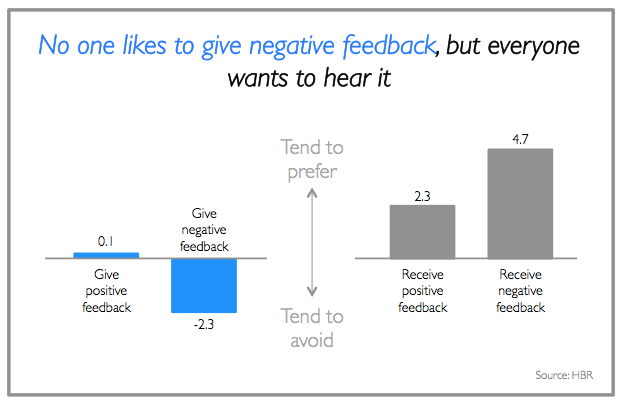Just as you owe it to people to praise them, you owe it to them to offer constructive feedback.
When you have individuals directly assigned to you, it is essential to be a teacher, mentor, positive critic, and advocate for their personal and career growth. You can’t do this if you aren’t giving constructive feedback.
Face it. As good as your employees may be, they will disappoint you. (Just as you have disappointed others.)
Regardless of your great example, careful delegation, and optimistic blind hope, people will make mistakes or engage in unproductive behavior. But a failure, unless it’s a moral or ethical one, is an opportunity for you to invest in your employee’s future.
When done well, giving constructive feedback to employees is as vital to their success as your praise is. No one can fix a problem they don’t know they have. And your employees actually want the feedback you may hate to give, according to Harvard Business Review.

So do your employees and yourself a favor and work on improving the quality and frequency of giving constructive feedback.
The Right Environment Is Crucial To Giving Constructive Feedback
The first step to giving constructive feedback is to create an environment of acceptance for your employees. This means that you accept your employees for who they are rather than judging their character and motives.
It starts with you and the way you view and treat people. Your title, position, and power means nothing. The only thing that matters is your consistent, genuine, honest, nonjudgmental attitude toward your employees.
Accepting people for who they are without judgment means they’ll be more likely to hear you when you are addressing a behavior or action. If you don’t give acceptance, even simple differences can turn into contradictions, resentment, contentiousness, and conflict.
When people feel valued and accepted, they can hear your comments on their behavior as comments on what they do, not on who they are.
When you have individuals directly assigned to you, it is essential to be a teacher, mentor, positive critic, and advocate for their personal and career growth. @debrabenton on 7 Steps For Giving Constructive Feedback To Your Employees… Share on XSeven Practical Steps to Giving Constructive Feedback To Employees

If you’ve crafted an environment of acceptance, the following steps will help you give constructive criticism in a way that helps the recipient hear and process it.
- Don’t Shoot The Messenger
- Double-Check Yourself
- Don’t Attack.
- Give It In Private.
- Avoid Being Repetitious Or Nagging.
- Be Specific And Be Brief.
- Explain The Consequences Of Their Action.
1. Don’t Shoot The Messenger
The first rule is to not shoot the messenger when you learn about a problem. You shouldn’t punish the deliverer of bad news. He or she will clam up next time or sugarcoat information, and you’ll end up not hearing about a problem at a time when you could possibly do something about it.
2. Double-Check Yourself
Before you find fault, double-check yourself: Are you responding to cronyism or favoritism? Are you looking at all sides? Do you have as many of the facts as possible? Are you being fair?
Being self-aware of your biases and taking the time to look at the situation objectively will help you address the situation fairly.
3. Don’t Attack.

Don’t talk to people in a toxic way. Avoid using a disapproving facial expression, a harsh tone of voice, or sharp words. Instead, stick with the pass-the-salt tone, slight smile, and carefully chosen words.
You don’t want to imply that anything is wrong with the person. You aren’t trying to tear down your employees but give them a path to better performance.
Don’t talk to people in a toxic way. Avoid using a disapproving facial expression, a harsh tone of voice, or sharp words. Instead, stick with the pass-the-salt tone, slight smile, and carefully chosen words. 7 Steps For Giving… Share on X4. Give It In Private.
A sure-fire way to break the trust you’ve created with your employees is to criticize them in front of their peers. Not only will most people find this humiliating but they will be less likely to act on the issue being addressed because of the delivery. You may even motivate them to leave versus grow.
5. Avoid Being Repetitious Or Nagging.
Talk about behavior once, then twice, and finally a third time in a clear, concise and calm manner. You can only give people the opportunity to grow – you can’t make them do the right thing. Nagging them constantly will only diminish your expectations in their eyes.
6. Be Specific And Be Brief.
There’s no need to be long-winded, but you do need to state your expectations clearly. State the problem behavior (using an example if at all possible) and tell them what you want to see instead. Your goal is to make it crystal clear what changes you want to see in their behavior.
7. Explain The Consequences Of Their Actions If They Choose To Not Change.
Once you’ve explained the issue and set your expectations, state the consequences for not meeting expected behavior, and, if necessary, enforce them. Then step back, and let them figure out the way.
You have to trust that your employees will do what’s needed.
Good Leaders Know The Importance Of Giving Constructive Feedback

In the heat of the moment, giving constructive feedback to employees can look like a personal attack if it’s not handled well. But when it is handled well, your employees will have an easier time accepting what you have to say about their behaviors and actions.
The end goal is to present the idea that constructive feedback is the “breakfast of champions.” And in reality, it is. Without honest feedback and a clear roadmap for change, your employees won’t achieve the success they want. You, as the leader, owe it to them to provide the opportunity to do better.
Whether you want to improve how you give constructive feedback or are looking for some constructive feedback for yourself, I am here to help. Contact me to discuss coaching, or if you have a group of emerging leaders, for a speaking engagement.


Thanks for this post, I really found this very helpful.